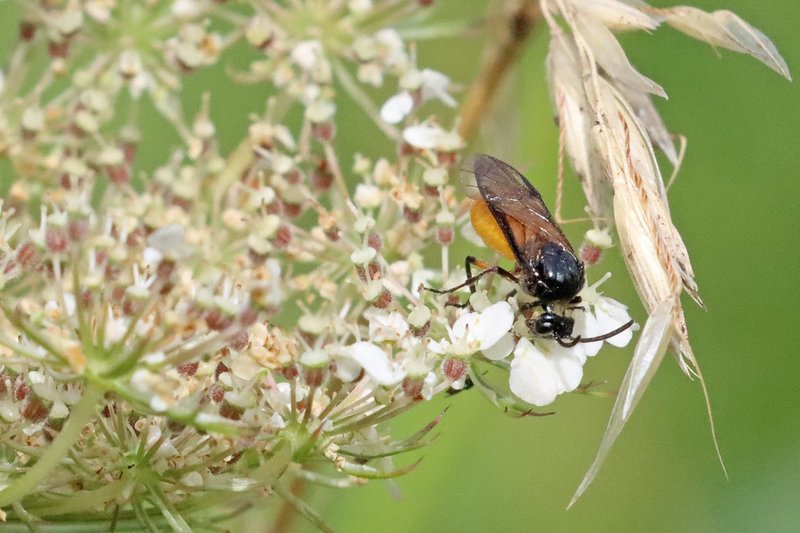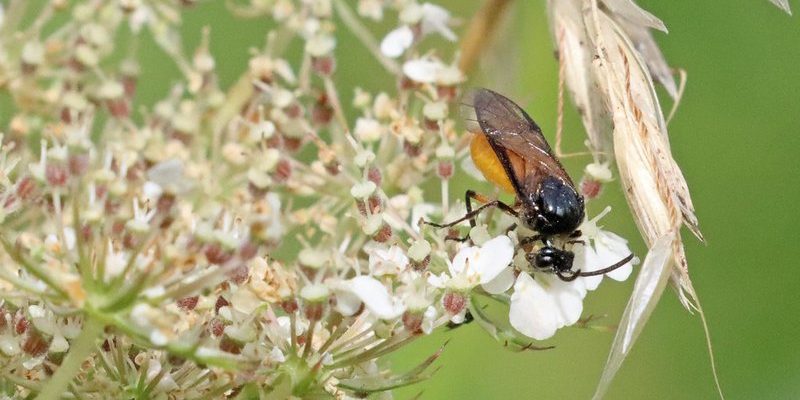
When you think of insects, you might picture bees buzzing, butterflies fluttering, or ants marching in a line. But tucked away in the world of insects is the sawfly, a fascinating creature that often flies under the radar. Sawflies belong to the order Hymenoptera, which means they’re related to wasps and bees. Unlike their more famous relatives, sawflies have a unique look and behavior that set them apart.
You might be wondering why they’re called “sawflies.” The name comes from the female’s saw-like ovipositor, which she uses to cut into plant tissue so she can lay her eggs. Imagine using a tiny, specialized tool to make a home for your babies! This method not only ensures the larvae have a safe start, but also affects the plants they choose as hosts, making sawflies a bit of a double-edged sword in nature.
While many people might overlook sawflies, they play a significant role in ecosystems. Some of them help with pollination, while others become a food source for birds and other animals. In this article, we’ll dive into the life of sawflies, how they impact their environments, and why understanding them is vital.
Physical Characteristics of Sawflies
Sawflies come in a variety of shapes, sizes, and colors, making them an intriguing subject of study. Most adult sawflies range from 0.25 to 1.5 inches long, though some species can be even larger. Their bodies are typically robust, with a smooth or slightly hairy appearance. They often sport a mix of colors, from bright greens and yellows to muted browns, helping them blend into their surroundings—a clever trick for avoiding predators.
Their heads are distinct, featuring large, compound eyes that provide excellent vision. Sawflies also have long antennae, which can be quite expressive. Think of these antennas as being similar to a dog’s ears—they can pick up on subtle environmental changes. But the real star feature is the aforementioned ovipositor, which can give rise to some pretty spectacular observations. You might spot a female sawfly sawing into a twig or leaf while preparing to lay her eggs.
It’s interesting to note that, unlike the bees and wasps they are related to, sawflies don’t have a stinger. Instead, they rely on their camouflage and behavior to avoid threats. In fact, many species engage in defensive behaviors, such as rolling into a ball or playing dead when confronted. These physical characteristics not only make sawflies fascinating but also vital to the biodiversity of their ecosystems.
The Lifecycle of Sawflies
The lifecycle of sawflies is a captivating journey that consists of several stages: egg, larva, pupa, and adult. After the female sawfly uses her ovipositor to lay eggs in plant material, the eggs hatch into larvae, commonly known as caterpillars. This stage is particularly important because larvae can cause significant damage to plants. In fact, they often feed on leaves, flowers, and stems, which can lead to defoliation if numbers are high.
What’s fascinating about sawfly larvae is their appearance—they resemble caterpillars but are distinctly different. They usually have a more robust body and can sometimes display vibrant colors. In some cases, they even mimic the colors of other insects to ward off predators. It’s a classic case of “don’t eat me, I’m not tasty!” during the larval stage. The larvae continue to feed voraciously until they reach maturity and are ready to pupate.
Pupation occurs in a protective casing made from silk or plant material, depending on the species. This stage can last from a few weeks to several months, depending on environmental conditions. Once they emerge as adults, the sawfly is ready to continue the cycle. It’s almost poetic how these little creatures navigate their lives, playing various roles in their ecosystems from plant-eating larvae to pollinating adults.
Habitat and Distribution
Sawflies are not picky when it comes to finding a suitable home. You can find them in diverse habitats, ranging from meadows and gardens to forests and wetlands. They thrive in locations where their host plants are plentiful, as the larvae rely heavily on these plants for food. This adaptability is one reason why sawflies are found across the globe, from North America to Europe and beyond.
Each species tends to have specific preferences for habitat types. Some are more common in deciduous forests, where they feed on hardwood trees, while others prefer shrubs and herbaceous plants in open fields. This diversity not only helps them survive in different environments but also contributes to the rich tapestry of life found in these areas. The intricate connections between plants, sawflies, and their predators create a dynamic ecosystem.
Climate can also play a role in their distribution. Warmer temperatures may promote a higher population density, leading to potential outbreaks where they can quickly strip foliage from trees and plants. These outbreaks can have cascading effects on the environment, influencing not just the sawflies and their host plants, but also the animals that rely on those plants for food and shelter. Understanding how habitat affects sawflies helps us appreciate their importance in maintaining ecological balance.
The Role of Sawflies in Ecosystems
Sawflies might be small, but their role in the ecosystem is undoubtedly significant. As larvae, they serve as herbivores that help to control plant populations. By feeding on various plants, they contribute to the natural cycle of growth and decay, allowing for healthier environments. In this way, sawflies can actually promote plant diversity by preventing any single species from becoming overly dominant.
On the flip side, sawflies also become food for various predators. Birds, mammals, and even other insects depend on sawflies as a source of nutrition. This creates an intricate web of life where each species, no matter how small, plays its part. When sawfly populations surge, they provide an abundance of food for these predators, influencing the population dynamics of the entire ecosystem.
Additionally, as adults, some sawflies can act as pollinators. While they may not be as efficient as bees, they do visit flowers in search of nectar, assisting in the transfer of pollen. This aspect of their behavior can help support the growth and reproduction of various plants, enhancing the biodiversity of their habitats. It’s a clear example of how interconnected life truly is.
Interaction with Humans
For the most part, sawflies tend to keep to themselves and don’t pose a direct threat to humans. However, they can become a nuisance when their larvae feast on garden plants and crops. If you’ve ever found your beloved rose bush looking a bit worse for wear, it might be worth checking for sawfly larvae munching away on the leaves. Understanding this can lead you to take action rather than frustration when you notice damage.
Fortunately, there are ways to manage sawfly populations if they become problematic. Handpicking the larvae off plants or using insecticidal soap are common, environmentally friendly methods to control them. Also, planting a variety of species can help minimize the impact of sawflies, as they often favor certain types of plants. By being proactive, gardeners can create a balance that allows sawflies to thrive while protecting their own plants.
Interestingly, sawflies have also caught the attention of scientists. Researchers study their behavior and lifecycles to better understand ecological dynamics and pest control. This curiosity-driven science has led to a more profound respect for sawflies—not just as pests, but as vital components of our ecosystems. In a way, they remind us that every creature, no matter how small, plays a part in the great puzzle of life.
Interesting Sawfly Facts
| Size: | 0.25 to 1.5 inches long, varies by species |
| Habitat: | Meadows, gardens, forests, wetlands |
| Diet: | Herbaceous and woody plants, leaves, flowers |
| Lifespan: | Varies; typically several weeks to months depending on species |
| Development Stages: | Egg, larva (caterpillar), pupa, adult |
FAQ
What do sawflies eat?
Sawflies primarily feed on leaves, flowers, and stems of various plants. Their diet can vary widely among species, with some preferring specific types of plants. This feeding behavior is essential for their growth, especially during the larval stage when they need to consume large quantities of plant material to mature.
Are sawflies harmful to plants?
In moderate numbers, sawflies can play a role in maintaining healthy ecosystems by preventing any single species of plant from becoming too dominant. However, in high populations, their feeding can lead to significant damage, such as defoliation of trees and shrubs. Home gardeners may need to keep an eye out for infestations and take appropriate action if damage occurs.
How can I control sawfly populations in my garden?
Controlling sawfly populations can be done through several methods. Handpicking the larvae or using insecticidal soap can be effective approaches. Additionally, introducing beneficial insects that prey on sawflies can help naturally control their numbers. Planting a diversity of species also discourages sawflies from becoming overly abundant on specific plants.
Do sawflies have any natural predators?
Yes, sawflies do have natural predators, including various birds, mammals, and other insects. Many birds find sawfly larvae to be a tasty snack, and certain parasitic wasps lay their eggs inside sawfly larvae, ultimately controlling their population. This natural balance is crucial in regulating sawfly numbers in their ecosystems.
Can sawflies be beneficial?
Absolutely! While they can be pests when their populations are high, sawflies contribute to ecosystems by acting as herbivores that help control plant populations and by serving as a food source for predators. Some sawfly species also aid in pollination, which is vital for many plants to reproduce and thrive.
How can I identify sawflies?
Sawflies can be identified by their robust bodies and unique features such as their saw-like ovipositors. Observing them feeding on specific plants can also provide clues, as different species have preferences for particular types of foliage. Their larvae often resemble caterpillars but are typically sturdier and may display different coloration patterns, which can assist in identification.
Are sawflies dangerous to humans?
No, sawflies are not dangerous to humans. Unlike some of their relatives, they lack stingers and do not pose any threat. They are more likely to scurry away when disturbed than to engage in any defensive behavior. Still, if you’re keen on keeping your garden healthy, it’s a good idea to monitor their populations.
Do sawflies hibernate?
Some sawfly species can enter a state of dormancy or hibernation during colder months. They often do this in the pupal stage, where they remain protected in the environment until spring warms up and conditions are right for emergence as adults. This adaptation allows them to survive through unfavorable weather.
What time of year are sawflies most active?
Sawflies are typically most active during the warmer months in spring and summer when their host plants are abundant. This is when adults emerge, mate, and lay their eggs, followed by the larvae feeding on plant material. Monitoring them during these times can help with effective management.
How do sawflies affect ecosystems?
Sawflies play a dual role in ecosystems. As herbivores, they contribute to plant diversity and health by preventing certain plants from becoming overly dominant. Additionally, they serve as prey for various predators, linking food webs and enriching biodiversity. Understanding their effects helps us appreciate the delicate balance of nature.
Where can I learn more about sawflies?
To learn more about sawflies, consider checking resources from agricultural extension offices, entomology departments at universities, or nature conservation organizations. Field guides and local nature centers can also provide valuable insights into sawfly behavior and ecology.

